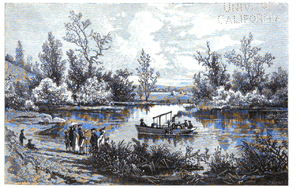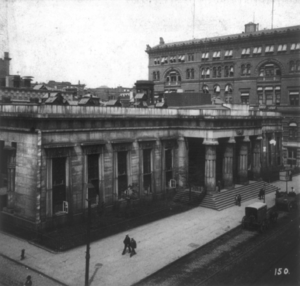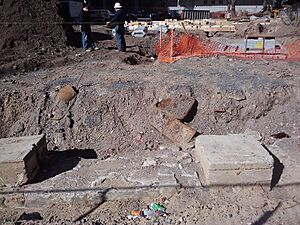Collect Pond facts for kids
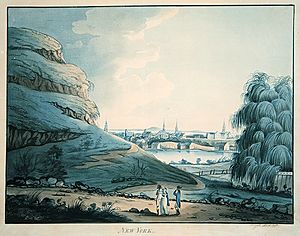
Collect Pond, also known as Fresh Water Pond, was a large freshwater pond in what is now the Chinatown area of Lower Manhattan, New York City. For about 200 years after Europeans settled in Manhattan, it was the main source of drinking water for the growing city. The area where the pond once was later became the site of a jail. Today, it is a city park called Collect Pond Park, which even has a small pond to remind people of its past.
Contents
What was Collect Pond like?
The pond covered about 48 acres (190,000 m2) and was as deep as 60 feet (18 m). It was fed by an underground spring and sat in a valley. To the northeast was Bayard Mount, the tallest hill in lower Manhattan at 110 feet or 34 metres. To the west was Kalck Hoek, a Dutch name meaning 'Chalk Point'. This name came from the many oyster shells left by the Native American people who lived there.
A stream flowed north from the pond, then west through a salt marsh to the Hudson River. Another stream flowed east from the southeastern part of the pond to the East River.
The southwestern shore of Collect Pond was home to a Native American village called Werpoes. A small group of Munsee people, part of the Lenape tribe, lived there. In 1542, the French built a trading post on an island in the pond. The Munsee continued to live at Collect Pond until the Dutch started the settlement of New Amsterdam in the 1600s.
Collect Pond was important for setting boundaries for night watch duties in 1731 during British rule in New York City. The pond had many fish. In 1734, a law was even passed to stop people from using nets to catch fish there. This was before the pond became very polluted from people dumping dead animals and other waste.
Collect Pond in the 1700s
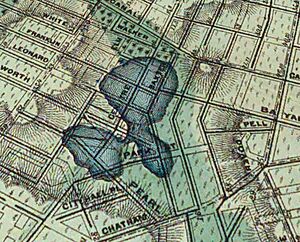
In the 1700s, the pond was a popular spot for picnics in the summer and a skating rink in the winter. Early in the 18th century, many businesses were built around the pond to use its water. These included a brewery, a slaughterhouse, several tanneries (places that make leather), and pottery workshops.
By the late 1700s, the pond was very dirty. People called it "a very sink and common sewer" because of all the waste.
John Fitch's Steamboat Experiment
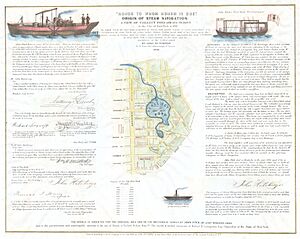
Connecticut inventor John Fitch was a skilled instrument maker in the late 1700s. He was one of the first people to work on steam-powered boats. Fitch tested several steamboats on the Delaware River between 1785 and 1788.
His biggest success happened in 1796 when he tested another ship with a paddle wheel on Collect Pond. With him on the boat were fellow inventor Robert Fulton, Robert R. Livingston (who signed the Declaration of Independence), and 16-year-old John Hutchings, who was steering.
This test happened six years before Fulton and Livingston launched their famous steamboat on the Seine River in France. Hutchings later said he was a "lad" who "assisted Mr. Fitch in steering the boat." In a paper from 1846, Hutchings claimed that Fitch was the one who designed the steam engine. He also said that both Fulton and Livingston were there during the Collect Pond tests.
Even though Fulton often gets most of the credit for steam navigation, Hutchings wanted to show how much Fitch had contributed. However, a plaque at Collect Pond Park says that while Fitch's story is often told, there is no clear proof to confirm it.
Pollution and Filling In
The dirty wastewater from the businesses around Collect Pond flowed back into it. This caused serious pollution and made the area unhealthy. Pierre Charles L'Enfant, a city planner, suggested cleaning the pond and turning it into a park. He thought it could be a beautiful center for the city's growing neighborhoods.
However, his idea was rejected. Instead, city leaders decided to fill in the pond. They used dirt and earth from leveling Bayard Mount and Kalck Hoek. The filling was finished in 1811, and soon, middle class homes were built on the new land.
But the landfill was not done well. Plants buried under the fill started to release methane gas as they decayed. Also, the area was still a natural low spot and did not have good storm sewers. Because of this, the ground slowly sank. Houses started to shift, and the unpaved streets were often covered in a foot of mud mixed with waste. Mosquitoes also bred in the stagnant pools caused by the poor drainage.
Decades later, New York City got a new, clean water supply from the Croton Aqueduct. The neighborhood known as "Five Points" grew near the former eastern bank of Collect Pond. This area became a very poor neighborhood partly because the bad landfill job created swampy, mosquito-filled conditions. Many middle and upper-class residents moved away, leaving the area open to poor immigrants who started arriving in the early 1820s. A large number of Irish Catholics came in the 1840s, fleeing the Great Famine.
The Tombs Jail
New York City's main jail, nicknamed "The Tombs", was built on Centre Street in 1838. It was located on the site of the former pond. To try and make it stable, the jail was built on a huge platform of hemlock logs. The building's design, by John Haviland, looked like an ancient Egyptian mausoleum (a large tomb). It was 253 feet (77 m) long and 200 feet (61 m) wide, covering a whole city block. It could hold about 300 prisoners.
The prison building began to sink almost as soon as it was finished. It was known for leaks on its lowest level and for being generally damp. The original building was torn down in 1902. A new jail was built on the same spot. This new building had a "Bridge of Sighs" connecting it to the Criminal Courts Building. When the first Tombs building was demolished, large concrete caissons (watertight structures) were placed deep into the ground, up to 140 feet below street level. This was done to give the new building a much stronger foundation. That building was replaced in 1941 by another one across the street, which is still popularly called "The Tombs."
Collect Pond Park Today
In 1960, a part of the old Collect Pond site was given to the New York City Department of Parks and Recreation to be made into a park. At first, it was called "Civil Court Park" because it was near the courthouse buildings. However, the park was later renamed "Collect Pond Park," its current name, to better show its history. The park is located on the block surrounded by Lafayette Street, Leonard Street, Centre Street, and White Street.
The park was closed for a full renovation. In 2012, during the reconstruction, workers found the granite foundation of the old Tombs jail. This discovery caused work to stop while archaeologists investigated. The newly rebuilt park reopened in May 2014. It now includes a small pond that reminds visitors of the original Collect Pond.
You can still get an idea of where Collect Pond used to be by looking at the height of the streets in the area. Centre Street, which runs through the middle of where the pond once was, is the lowest point.
Images for kids
-
A 1798 watercolor painting of Collect Pond. Bayard's Mount, a 110-foot (34 m) hillock, is in the left foreground.
See also
 In Spanish: Collect Pond para niños
In Spanish: Collect Pond para niños


